#microlense
Text
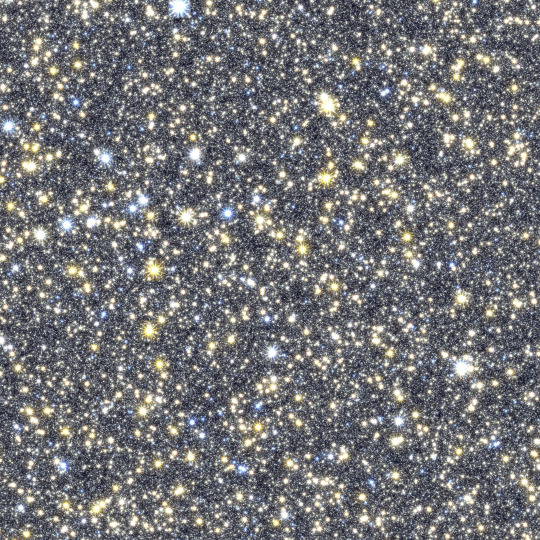
A simulated image of NASA’s Nancy Grace Roman Space Telescope’s future observations toward the center of our galaxy, spanning less than 1 percent of the total area of Roman’s Galactic Bulge Time-Domain Survey. The simulated stars were drawn from the Besançon Galactic Model.
Exploring the Changing Universe with the Roman Space Telescope
The view from your backyard might paint the universe as an unchanging realm, where only twinkling stars and nearby objects, like satellites and meteors, stray from the apparent constancy. But stargazing through NASA’s upcoming Nancy Grace Roman Space Telescope will offer a front row seat to a dazzling display of cosmic fireworks sparkling across the sky.
Roman will view extremely faint infrared light, which has longer wavelengths than our eyes can see. Two of the mission’s core observing programs will monitor specific patches of the sky. Stitching the results together like stop-motion animation will create movies that reveal changing objects and fleeting events that would otherwise be hidden from our view.
youtube
Watch this video to learn about time-domain astronomy and how time will be a key element in NASA’s Nancy Grace Roman Space Telescope’s galactic bulge survey. Credit: NASA’s Goddard Space Flight Center
This type of science, called time-domain astronomy, is difficult for telescopes that have smaller views of space. Roman’s large field of view will help us see huge swaths of the universe. Instead of always looking at specific things and events astronomers have already identified, Roman will be able to repeatedly observe large areas of the sky to catch phenomena scientists can't predict. Then astronomers can find things no one knew were there!
One of Roman’s main surveys, the Galactic Bulge Time-Domain Survey, will monitor hundreds of millions of stars toward the center of our Milky Way galaxy. Astronomers will see many of the stars appear to flash or flicker over time.
youtube
This animation illustrates the concept of gravitational microlensing. When one star in the sky appears to pass nearly in front of another, the light rays of the background source star are bent due to the warped space-time around the foreground star. The closer star is then a virtual magnifying glass, amplifying the brightness of the background source star, so we refer to the foreground star as the lens star. If the lens star harbors a planetary system, then those planets can also act as lenses, each one producing a short change in the brightness of the source. Thus, we discover the presence of each exoplanet, and measure its mass and how far it is from its star. Credit: NASA's Goddard Space Flight Center Conceptual Image Lab
That can happen when something like a star or planet moves in front of a background star from our point of view. Because anything with mass warps the fabric of space-time, light from the distant star bends around the nearer object as it passes by. That makes the nearer object act as a natural magnifying glass, creating a temporary spike in the brightness of the background star’s light. That signal lets astronomers know there’s an intervening object, even if they can’t see it directly.
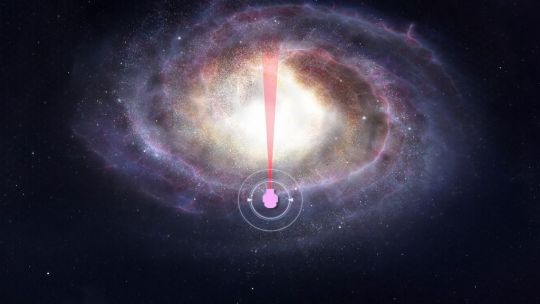
This artist’s concept shows the region of the Milky Way NASA’s Nancy Grace Roman Space Telescope’s Galactic Bulge Time-Domain Survey will cover – relatively uncharted territory when it comes to planet-finding. That’s important because the way planets form and evolve may be different depending on where in the galaxy they’re located. Our solar system is situated near the outskirts of the Milky Way, about halfway out on one of the galaxy’s spiral arms. A recent Kepler Space Telescope study showed that stars on the fringes of the Milky Way possess fewer of the most common planet types that have been detected so far. Roman will search in the opposite direction, toward the center of the galaxy, and could find differences in that galactic neighborhood, too.
Using this method, called microlensing, Roman will likely set a new record for the farthest-known exoplanet. That would offer a glimpse of a different galactic neighborhood that could be home to worlds quite unlike the more than 5,500 that are currently known. Roman’s microlensing observations will also find starless planets, black holes, neutron stars, and more!
youtube
This animation shows a planet crossing in front of, or transiting, its host star and the corresponding light curve astronomers would see. Using this technique, scientists anticipate NASA’s Nancy Grace Roman Space Telescope could find 100,000 new worlds. Credit: NASA’s Goddard Space Flight Center/Chris Smith (USRA/GESTAR)
Stars Roman sees may also appear to flicker when a planet crosses in front of, or transits, its host star as it orbits. Roman could find 100,000 planets this way! Small icy objects that haunt the outskirts of our own solar system, known as Kuiper belt objects, may occasionally pass in front of faraway stars Roman sees, too. Astronomers will be able to see how much water the Kuiper belt objects have because the ice absorbs specific wavelengths of infrared light, providing a “fingerprint” of its presence. This will give us a window into our solar system’s early days.
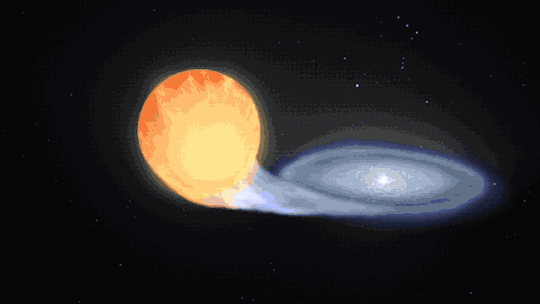
This animation visualizes a type Ia supernova.
Roman’s High Latitude Time-Domain Survey will look beyond our galaxy to hunt for type Ia supernovas. These exploding stars originate from some binary star systems that contain at least one white dwarf – the small, hot core remnant of a Sun-like star. In some cases, the dwarf may siphon material from its companion. This triggers a runaway reaction that ultimately detonates the thief once it reaches a specific point where it has gained so much mass that it becomes unstable.
youtube
NASA’s upcoming Nancy Grace Roman Space Telescope will see thousands of exploding stars called supernovae across vast stretches of time and space. Using these observations, astronomers aim to shine a light on several cosmic mysteries, providing a window onto the universe’s distant past. Credit: NASA’s Goddard Space Flight Center
Since these rare explosions each peak at a similar, known intrinsic brightness, astronomers can use them to determine how far away they are by simply measuring how bright they appear. Astronomers will use Roman to study the light of these supernovas to find out how quickly they appear to be moving away from us.
By comparing how fast they’re receding at different distances, scientists can trace cosmic expansion over time. This will help us understand whether and how dark energy – the unexplained pressure thought to speed up the universe’s expansion – has changed throughout the history of the universe.
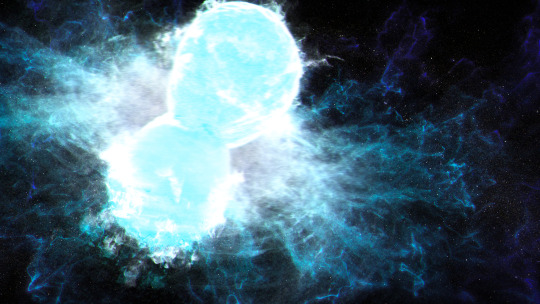
NASA’s Nancy Grace Roman Space Telescope will survey the same areas of the sky every few days. Researchers will mine this data to identify kilonovas – explosions that happen when two neutron stars or a neutron star and a black hole collide and merge. When these collisions happen, a fraction of the resulting debris is ejected as jets, which move near the speed of light. The remaining debris produces hot, glowing, neutron-rich clouds that forge heavy elements, like gold and platinum. Roman’s extensive data will help astronomers better identify how often these events occur, how much energy they give off, and how near or far they are.
And since this survey will repeatedly observe the same large vista of space, scientists will also see sporadic events like neutron stars colliding and stars being swept into black holes. Roman could even find new types of objects and events that astronomers have never seen before!
Learn more about the exciting science Roman will investigate on X and Facebook.
Make sure to follow us on Tumblr for your regular dose of space!
#NASA#astronomy#telescope#Roman Space Telescope#dark energy#galaxies#cosmology#astrophysics#stars#galaxy#space images#time#supernova#Nancy Grace Roman#black holes#neutron stars#kilonova#rogue planets#exoplanets#space#science#tech#technology#Youtube
3K notes
·
View notes
Text
THE UNIVERSE COULD BE FILLED WITH ULTRALIGHT BLACK HOLES THAT CAN'T DIE??
Blog#400
Saturday, May 11th, 2024.
Welcome back,
Primordial black holes are hypothetical objects formed during the earliest moments of the universe. According to the models, they formed from micro-fluctuations in matter density and spacetime to become sand grain-sized mountain-massed black holes.
Although we've never detected primordial black holes, they have all the necessary properties of dark matter, such as not emitting light and the ability to cluster around galaxies. If they exist, they could explain most of dark matter.
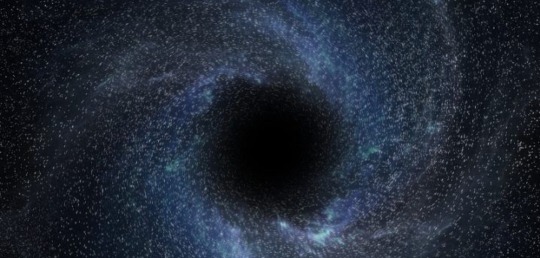
The downside is that most primordial black hole candidates have been ruled out by observation. For example, to account for dark matter there would have to be so many of these gravitational pipsqueaks that they would often pass in front of a star from our vantage point. This would create a microlensing flare we should regularly observe. Several sky surveys have looked for such an event to no avail, so PBH dark matter is not a popular idea these days.
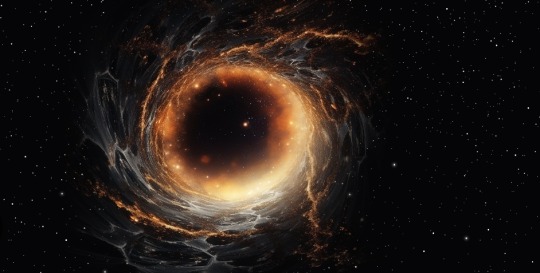
A new work, posted to the arXiv preprint server, takes a slightly different approach. Rather than looking at typical primordial black holes, it considers ultralight black holes. These are on the small end of possible masses and are so tiny that Hawking radiation would come into play.
The rate of Hawking decay is inversely proportional to the size of a black hole, so these ultralight black holes should radiate to their end of life on a short cosmic timescale.
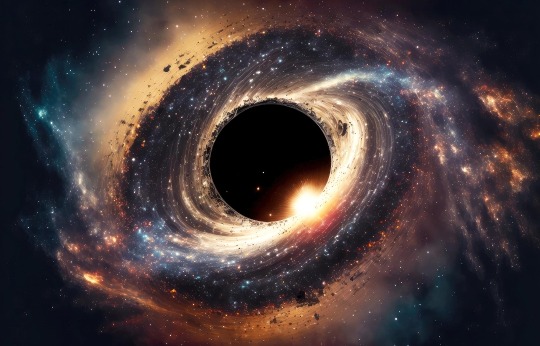
Since we don't have a full model of quantum gravity, we don't know what would happen to ultralight black holes at the end, which is where this paper comes in.
As the author notes, basically there are three possible outcomes. The first is that the black hole radiates away completely. The black hole would end as a brief flash of high-energy particles. The second is that some mechanism prevents complete evaporation and the black hole reaches some kind of equilibrium state. The third option is similar to the second, but in this case, the equilibrium state causes the event horizon to disappear, leaving an exposed dense mass known as a naked singularity.

The author also notes that for the latter two outcomes, the objects might have a net electric charge.
For the evaporating case, the biggest unknown would be the timescale of evaporation. If PBHs are initially tiny they would evaporate quickly and add to the reheating effect of the early cosmos. If they evaporate slowly, we should be able to see their deaths as a flash of gamma rays. Neither of these effects has been observed, but it is possible that detectors such as Fermi's Large Area Telescope might catch one in the act.
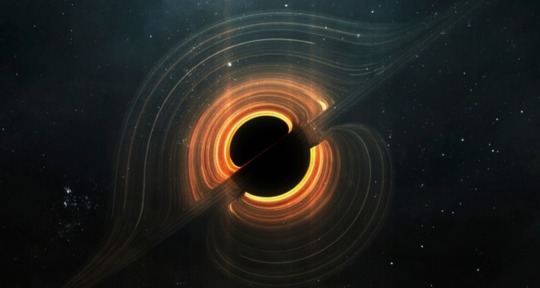
For the latter two options, the author argues that equilibrium would be reached around the Planck scale. The remnants would be proton-sized but with much higher masses. Unfortunately, if these remnants are electrically neutral they would be impossible to detect. They wouldn't decay into other particles, nor would they be large enough to detect directly. This would match observation, but isn't a satisfying result.
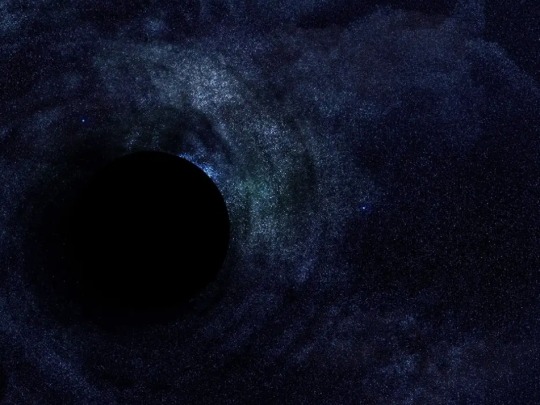
The model is essentially unprovable. If the particles do have a charge, then we might detect their presence in the next generation of neutrino detectors.
The main thing about this work is that primordial black holes aren't entirely ruled out by current observations. Until we have better data, this model joins the theoretical pile of many other possibilities.
Originally published on https://phys-org.
COMING UP!!
(Wednesday, May 15th, 2024)
"DOES THE UNIVERSE EXPAND BY STRETCHING OR CREATING SPACE??"
#astronomy#outer space#alternate universe#astrophysics#universe#spacecraft#white universe#space#parallel universe#astrophotography
53 notes
·
View notes
Text
Gravitational Lensing Notes
I've decided to finally start this series so I can share my notes as I'm working through Gravitational Lensing by Scott Dodelson. The book itself is a great read, and the goal of my notes is to "fill in the gaps". This basically means that when I see a paragraph I don't quite understand, I reword it in a way that makes sense to my brain. For equations, I fill in the steps that are left implied, so I'm not stuck next time wondering where some extra term came from. I make these notes for myself, but I am sharing them in case it's useful to see an example of how to self-study from a textbook, or if you happen to also be reading this book (hey then maybe we should make a book club).
Chapter One - Overview
Notes under the cut, because this will get long.

Remember that radians are unitless, so we expect this for an angle.

The sun lensing the positions of known stars is a unique case where the amount of lensing can be determined. This is not usually the case. How this is addressed in other situations will be explored in the rest of this chapter.
There are three types of lens/source types: point mass, a single extended source, and multiple diffuse sources.

1.1 Multiple Images
Consider now the simplest case: a point mass lensed by another point mass.



1.2 Time Delay
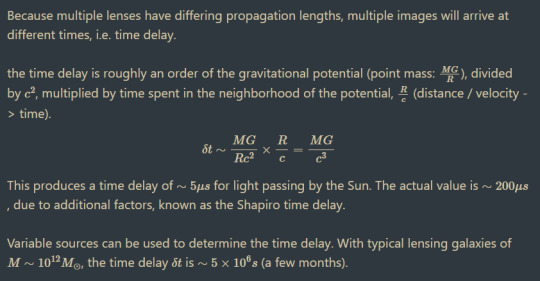
1.3 Magnification
Lensing conserves surface brightness (see exercise 1.3), so the flux of an object depends on its apparent size. Flux is focused onto the observer when a lens is present. Magnification is given by the ratio of lensed/unlensed size.
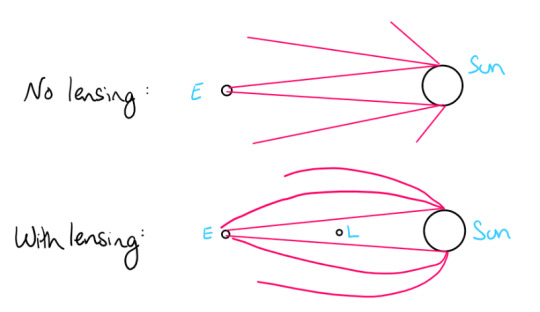


1.4 Microlensing

1.5 Extended Lenses


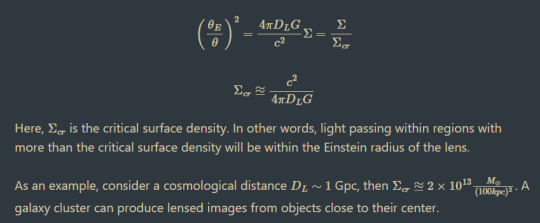
1.6 Extended Sources





1.7 Diffuse Lenses



1.8 CMB Lensing

12 notes
·
View notes
Text

Technology advance could expand the reach of 3D nanoprinting
Researchers have developed an easy-to-build, low-cost 3D nanoprinting system that can create arbitrary 3D structures with extremely fine features. The new 3D nanoprinting technique is precise enough to print metamaterials as well as a variety of optical devices and components such as microlenses, micro-optical devices and metamaterials.
"Our system uses a two-step absorption process to realize 3D printing with accuracy reaching the nanometer level, which is suitable for commercial manufacturing," said research team leader Cuifang Kuang from the Zhejiang Lab and Zhejiang University, both in China. "It can be used for a variety of applications such as printing micro or nanostructures for studying biological cells or fabricating the specialized optical waveguides used for virtual and augmented reality devices."
Conventional high-resolution 3D nanoprinting approaches use pulsed femtosecond lasers that cost tens of thousands of dollars. In Optics Letters, Kuang and colleagues describe their new system based on an integrated fiber-coupled continuous-wave laser diode that is not only inexpensive but also easy to operate.
Read more.
46 notes
·
View notes
Text

How NASA citizen science fuels future exoplanet research
NASA's upcoming flagship astrophysics missions, the Nancy Grace Roman Space Telescope and the Habitable Worlds Observatory, will study planets outside our solar system, known as exoplanets. More than 5,000 exoplanets have been confirmed to date—and given that scientists estimate at least one exoplanet exists for every star in the sky, the hunt has just begun.
Exoplanet discoveries from Roman and the Habitable Worlds Observatory may not be made only by professional researchers, but also by interested members of the public, known as citizen scientists.
Exoplanet research has a long involvement with citizen science. NASA's TESS (Transiting Exoplanet Survey Satellite) mission and the now-retired Kepler mission, which are responsible for the vast majority of exoplanet discoveries to date, made observations freely available to the public immediately after processing. This open science policy paved the way for the public to get involved with NASA's exoplanet science.
NASA's Planet Hunters TESS project invites the public to classify exoplanet light curves from TESS online. Another project, Exoplanet Watch, allows citizen scientists to gather data about known exoplanets, submit their observations to NASA's public data archive, and receive credit if their observation is used in a scientific paper. Participants don't even need their own telescope—Exoplanet Watch also curates data from robotic telescopes for users to process.
"Anyone across the world who has access to a smartphone or a laptop can fully participate in a lot of these citizen science efforts to help us learn more about the cosmos," said Rob Zellem, the project lead and project scientist for Exoplanet Watch and astrophysicist at NASA's Goddard Space Flight Center in Greenbelt, Maryland.
NASA's citizen science projects have discovered several new planets from Kepler and TESS data. They have also helped scientists refine the best time to observe important targets, saving hours of precious observation time on current flagship missions like NASA's James Webb Space Telescope.
Roman and the Habitable Worlds Observatory provide even more possibilities for citizen science. Expected to launch by May 2027, Roman will discover exoplanets through direct imaging, transits, and gravitational microlensing. Following that, the Habitable Worlds Observatory will take direct images of stars in our solar neighborhood to find potentially habitable planets and study their atmospheres.
Like Kepler and TESS before them, data from Roman and the Habitable Worlds Observatory will be available to both the scientific community and the public immediately after processing. With Roman's surveys expected to deliver a terabyte of data to Earth every day—over 17 times as much as Webb—there is a huge opportunity for the public to help sift through the information.
"The general public can get Roman data as quickly as I can as a scientist working on the mission," said Zellem, who also serves as Roman's deputy project scientist for communications at NASA Goddard. "It truly makes Roman a mission for everyone and anyone."
Although the Habitable Worlds Observatory's full capabilities and instrumentation have yet to be finalized, the inclusion of citizen science is expected to continue. The team behind the mission is embracing a community-oriented planning approach by opening up working groups to volunteers who want to contribute.
"It's already setting the tone for open science with the Habitable Worlds Observatory," said Megan Ansdell, the program scientist for the mission at NASA Headquarters in Washington. "The process is as open as possible, and these working groups are open to anybody in the world who wants to join." There are already more than 1,000 community working group members participating, some of whom are citizen scientists.
Future citizen science initiatives may be combined with cutting-edge tools such as artificial intelligence (AI) for greater efficacy. "AI can be exceptionally powerful in terms of classification and identifying anomalous things," said Joshua Pepper, the deputy program scientist for the Habitable Worlds Observatory at NASA Headquarters. "But the evaluation of what those anomalous things are often requires human insight, intervention, and review, and I think that could be a really fantastic area for citizen scientists to participate."
Before Roman and the Habitable Worlds Observatory launch, exoplanet citizen scientists still have plenty of data to analyze from the Kepler and TESS satellites, but the contributions of the community will become even more important when data begins pouring in from the new missions. As Zellem said, "We're in a golden age of exoplanet science right now."
IMAGE: This artist's concept shows the exoplanet K2-33b transiting its host star. Many citizen science projects at NASA invite the public to use transit data to make discoveries about exoplanets. Credit: NASA/JPL-Caltech
4 notes
·
View notes
Photo

A Network of Microlensing Caustics
Credits: Joachim Wambsganss, Ap. Inst. Potsdam
6 notes
·
View notes
Text

Microlensing of the Einstein Cross - July 11th, 1995.
“The famous "Einstein Cross" is a case where a single object is seen four times. Here a very distant QSO happened to be placed right behind a massive galaxy. The gravitational effect of the galaxy on the distant QSO was similar to the lens effect of a drinking glass on a distant street light - it created multiple images. But stars in the foreground galaxy have been found to act as gravitational lenses here too! These stars make the images change brightness relative to each other. These brightness changes are visible on these two photographs of the Einstein Cross, taken about 3 years apart.”
3 notes
·
View notes
Text
youtube
Exoplanets are any planets beyond our solar system. Five most prominent methods of detection of exoplanets are radial velocity or wobble method, transit spectroscopy method, gravitational microlensing method, direct imaging method and Astrometry method.
The radial-velocity method, also known as the wobble method, is an indirect method for detecting extrasolar planets and brown dwarfs by observing Doppler shifts in the spectrum of the planet's parent star.
A transit is a phenomenon that occurs when a celestial body passes directly between another celestial body and the observer. Transit method types are transit spectroscopy, Transit timing variation and Transit duration variation. Transit method is the most prominent method of detection of exoplanets.
Gravitational Microlensing uses the "gravitational lensing" a concept proposed by Albert Einstein to detect exoplanets or extrasolar planets.
Telescopes are used to directly image the exoplanets using the direct imaging method of detecting exoplanets.
Astrometry is the technique which deals with the positions and motions of celestial objects like stars and planets.
#exoplanet#exoplanets#exoplanetology#outer space#space#astrobiology#astrophysics#astronomy#astronomers#Youtube
5 notes
·
View notes
Text
Human Eye Pigments and also a tangent on Oil Droplets Found in Photoreceptor Cells In Birds' Eyes
ok so. pigments in the iris of the human eye!! Lipochrome is also called lipofuschin and its a carotenoid pigment!!

This infographic does not have grey eyes but grey eyes are basically due to irises that have very little melanin and have more coarse collagen in the stroma of the iris and this causes the light to reflect in a way that makes the iris appear grey
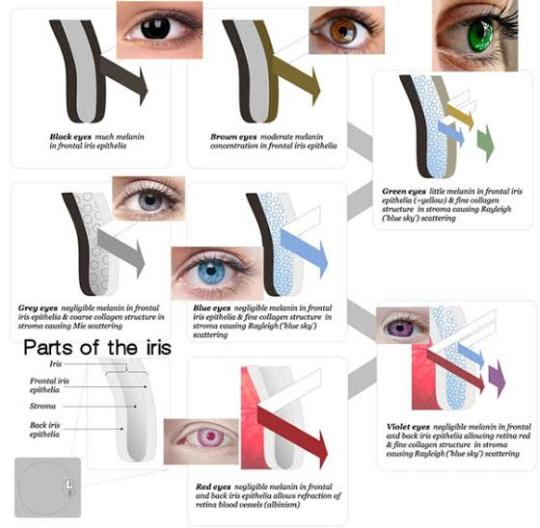
This image explains what colors get scattered by the stroma and the resultant eye color.
Now about the birds..
I also remembered that birds have some carotenoid pigments in their eyes. Those are in the form of oil droplets too in some birds (they apparently have the same visual pigments as humans which are rhodopsins - which is formed after vitamin A or retinol undergoes a cycle known as Wald's visual cycle).

And this image above shows where the oil droplet is present in the cone cell(cone cells are responsible for color vision and daytime vision). These oil droplets are also found in rod cells occasionally(rod cells are for night vision/low light and black and white vision) but not as often, so these oil droplets play more of a role in diurnal species.
So they have visual pigments but in addition to that, some birds eyes have oil droplets containing carotenoid pigments in front of cone cells that act as spectral filters, like spherical microlenses, and help channel light. These oil droplets are also found in some reptiles, fish, and amphibians, and were actually first studied in turtles!
(links for further reading below!)
This one is a research article from 2014, its open access so not behind a paywall.
This is a science news article from Purdue about a type of retinal structure that contains megamitochondria(a structure producing energy) and oil droplets (MMOD or megamitochondria-oil droplet complex) that was discovered in flycatchers(a type of passerine, or songbird) in 2019.
This study was done on new world flycatchers (various species of the Empidonax genus, specifically). A flycatcher is a 'sit-and-wait' predator of insects(what says on the tin- the bird waits on a branch and catches insects when it sees them) and this eye structure enables precise visual tracking. And below is the link to the study itself which is also open access.
#eye#eyes#tw eye#tw eyes#human eye#tw human eye#birds#bird#ornithology#opthalmology#I will really see the word lipochrome w reference to eyes in gtn then make this entire post huh /lh#mmod complex#oil droplets#visual pigments#carotenoids#birdblr#scienceblr#<-may untag if that iz for like actual scientists idk???#science#biology#optics#physics#biophysics
1 note
·
View note
Text

One to many
We are starting with the output of a telephoto zoom, coupled with a fisheye lens, its unusual I know but if you bear with me, next we are building a dark chamber around it, facing a convex microlens array
One image to many, one from the fish eye, to many in the microlens array, we have simplified things by showing an 8 by 8 matrix or 64 microlenses in total, these could be 100 times as much
ie we are going into the optics that we said we wouldn't touch, why one to many, in each of these microlenses we should have an exact reflection of the image from the fisheye lens, although smaller, a property of convex lenses facing one another
Which I knew of not being an expert in optics, but it's pretty common, and we are applying it here
Now these many images coupled with fiber optics allow us to process that same image from the fisheye upwards to 6400 times or more, microlenses can be very small, and by now although we are using the term microlenses we should be looking at something slightly larger because the smaller we go the more the optics properties of these lenses become tricky
If these lenses turn out to be much bigger, having fiber optics to close the gap between the front optics chambers and instruments in the back would become irrelevant since larger lenses should bridge that distance, they would still be segregated however to keep things tidy
What else, yes telephoto zooms, the Canon 1200 USM and 800 USM look promising, so 4 of them, 1200 exterior 800 interior
Why go to the trouble of magnifying refracted light, why not in fact, maybe it's an image and refraction takes place afterwards not right from the start, also HEXIRON doesn't have any magnifying capacity, aside from the large hyperspectral imaging captors, but not optic based
Good reading if you started here, laziness will not serve you well it serves only itself
0 notes
Text
Scary Space Stories to Tell in the Dark
The universe is full of dazzling sights, but there’s an eerie side of space, too. Nestled between the stars, shadowy figures lurk unseen. The entire galaxy could even be considered a graveyard, full of long-dead stars. And it’s not just the Milky Way – the whole universe is a bit like one giant haunted house! Our Nancy Grace Roman Space Telescope will illuminate all kinds of spine-chilling cosmic mysteries when it launches in 2027, but for now settle in for some true, scary space stories.

Flickering Lights
One of the first signs that things are about to get creepy in a scary movie is when the lights start to flicker. That happens all the time in space, too! But instead of being a sinister omen, it can help us find planets circling other stars.
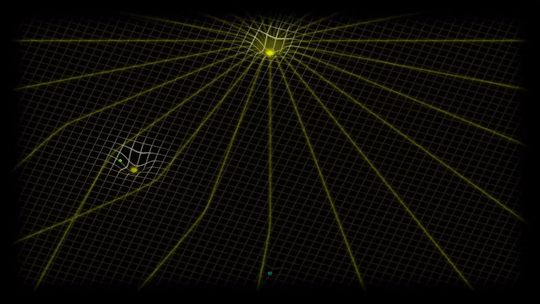
Roman will stare toward the heart of our galaxy and watch to see when pairs of stars appear to align in the sky. When that happens, the nearer star – and orbiting planets – can lens light from the farther star, creating a brief brightening. That’s because every massive object warps the fabric of space-time, changing the path light takes when it passes close by. Roman could find around 1,000 planets using this technique, which is called microlensing.
youtube
The mission will also see little flickers when planets cross in front of their host star as they orbit and temporarily dim the light we receive from the star. Roman could find an additional 100,000 planets this way!
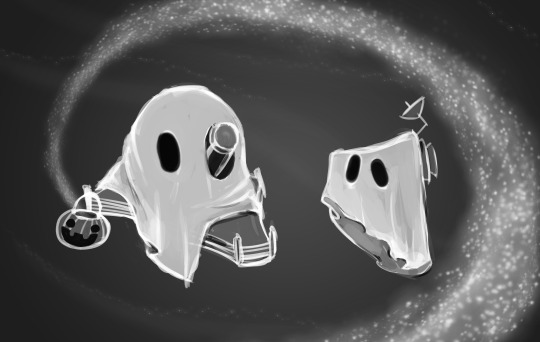
Galactic Ghosts
Roman is going to be one of the best ghost hunters in the galaxy! Since microlensing relies on an object’s gravity, not its light, it can find all kinds of invisible specters drifting through the Milky Way. That includes rogue planets, which roam the galaxy alone instead of orbiting a star…
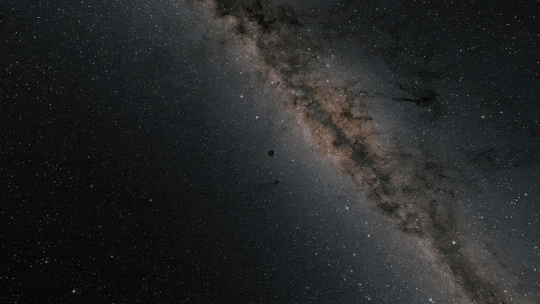
…and solo stellar-mass black holes, which we can usually only find when they have a visible companion, like a star. Astronomers think there should be 100 million of these black holes in our galaxy.

Stellar Skeletons
Black holes aren’t the only dead stars hiding in the sky. When stars that aren’t quite massive enough to form black holes run out of fuel, they blast away their outer layers and become neutron stars. These stellar cores are the densest material we can directly observe. One sugar cube of neutron star material would weigh about 1 billion tons (or 1 trillion kilograms) on Earth! Roman will be able to detect when these extreme objects collide.

Smaller stars like our Sun have less dramatic fates. After they run out of fuel, they swell up and shrug off their outer layers until only a small, hot core called a white dwarf remains. Those outer layers may be recycled into later generations of stars and planets. Roman will explore regions where new stars are bursting to life, possibly containing the remnants of such dead stars.

Cosmic Cobwebs
If we zoom out far enough, the structure of space looks like a giant cobweb! The cosmic web is the large-scale backbone of the universe, made up mainly of a mysterious substance known as dark matter and laced with gas, upon which galaxies are built. Roman will find precise distances for more than 10 million galaxies to map the structure of the cosmos, helping astronomers figure out why the expansion of the universe is speeding up.

Learn more about the exciting science this mission will investigate on Twitter and Facebook.
Make sure to follow us on Tumblr for your regular dose of space!
2K notes
·
View notes
Text
Samsung’s ISOCELL HP9 Redefines Telephoto Photography

Three new mobile image sensors, the ISOCELL HP9, ISOCELL GNJ, and ISOCELL JN5, are intended for use with smartphones’ primary and secondary cameras. Samsung Electronics, a global leader in innovative semiconductor technology, announced their release .
With its industry-leading 200MP and 50MP sensors, the new series bridges the gap between main and sub cameras for improved photography from every angle.
Samsung’s most recent image sensors produce amazing images from every angle, setting a new benchmark for mobile photography as customer expectations for smartphone camera quality and performance continue to climb.
According to Jesuk Lee, Executive Vice President and CTO of Samsung Electronics‘ System LSI Sensor Business Team, “the new direction of the industry is enhancing image sensor performance and bridging the gap between main and sub cameras to offer a consistent photography experience across all angles.” “With our new lineup of mobile sensors that integrate the latest advancements, we will continue to set industry standards and push technological boundaries.”
ISOCELL HP9
The First 200MP Telephoto Sensor in the Industry for Smartphones. With an optical format of 1/1.4 inches, the ISOCELL HP9 has 200 million 0.56-micrometer (μm) pixels.
The ISOCELL HP9 dramatically improves light-gathering capacity by directing more light precisely to the corresponding RGB colour filter thanks to its unique high-refractive microlens made of a novel material. With 12% better light sensitivity (based on signal-to-noise ratio 10) and 10% better autofocus contrast performance than the previous model, this leads to more vibrant colour reproduction and improved focus.
Possible Advantages
Professional-Grade Telephoto Photography the ISOCELL HP9 has the power to completely transform smartphone telephoto features by enabling consumers to take amazing up-close pictures.
Better Zooming: The ISOCELL HP9’s high resolution allows for lossless or minimal-loss zoom, which maintains image clarity even while enlarging on far-off objects.
Sharper Low-Light Photos: Even in poorly lit areas, crisp and detailed photographs may be taken because to the enhanced low-light performance.
Especially, the ISOCELL HP9 performs exceptionally well in low light, which solves a problem that classic telephoto cameras sometimes face. Its Tetra pixel technology combines 16 (4×4) pixels into a huge, 2.24μm-sized, 12MP sensor, making portrait images crisper even in low light and producing striking out-of-focus bokeh effects.
Telephoto cameras are finding more space as the primary cameras in high-end smartphones get bigger. The ISOCELL HP9 can be used with telephoto modules due to its large optical format, which rivals the capabilities of premium main cameras in terms of autofocus, high dynamic range (HDR), and frames per second (fps).
With a 3x zoom telephoto module, the HP9 can achieve up to 12x zoom while keeping sharp image quality. It is powered by a remosaic technique and supports 2x or 4x in-sensor zoom modes.
ISOCELL GNJ
Introducing Innovative Cutting-Edge Pixel Technology into ISOCELL GNJ. With 50 million 1.0μm pixels in an optical format of 1/1.57 inches, the ISOCELL GNJ is a dual pixel sensor.
With two photodiodes per pixel, autofocus is able to function quickly and precisely, much like human vision does. In order to focus quickly and maintain image quality, the image sensor also simultaneously records full colour information.
The GNJ offers higher-resolution photos devoid of artefacts or moiré patterns in photo mode and sharper footage in video mode thanks to a combination of dual pixel technology and an in-sensor zoom capability.
Together with Samsung’s unique high-refractive microlense, the recently enhanced high-transmittance anti-refractive layer (ARL) not only increases light transmission and minimises undesired reflections, but it also makes sure that dark areas are not unduly brightened for more accurate images with preserved image details.
The GNJ also has an improved pixel isolation material in deep trench isolation (DTI) that reduces crosstalk between neighbouring pixels by switching from polysilicon to silicon oxide. The sensor is able to take sharper, more detailed pictures as a result.
With a 29% improvement in preview mode and a 34% improvement in video mode at 4K 60 frames per second, all of these advances have been made with less power usage.
ISOCELL JN5
Robust Camera Experience From All Viewpoints With Wide Colour Gamut and Superior Autofocus. With an optical format of 1/2.76 inches, the ISOCELL JN5 has 50 million 0.64μm pixels.
By increasing charge transfer within pixels, Dual Vertical Transfer Gate (Dual VTG) technology significantly reduces noise for sharper images in extremely low light.
Using Super Quad Phase Detection (Super QPD), the ISOCELL JN5 captures even the finest details of fast-moving objects with little vibration by measuring phase variations both vertically and horizontally to adjust focus.
The ISOCELL JN5 also uses dual slope gain (DSG) technology to improve its HDR. This approach increases the spectrum of colours that the sensor can create by amplifying the analogue light information entering the pixels into two signals, converting them into digital data, and then combining them into one data.
Putting hardware remosaic methods into practice speeds up camera shooting and allows for instantaneous real-time zoom in both preview and capture modes.
A consistent camera experience from a variety of angles is guaranteed by the ISOCELL JN5’s small optical format, which makes it extremely versatile for usage with main and sub cameras, including wide-angle, ultra-wide-angle, front, and telephoto.
Read more on Govindhtech.com
0 notes
Text
0 notes
Text
Astronomy News Today
Whether it’s the first black hole image or the hijinks of Betelgeuse, astronomy news today is sure to make you say, “wow.” Here, find all the latest celestial reports and observing tips that have astronomers scratching their heads.
Scientists have spotted the 1st free-floating planet in our solar system using a technique called gravitational microlensing. The team behind the discovery used TESS…
View On WordPress
0 notes
Text
0 notes